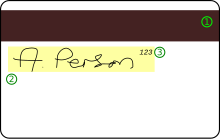Magnetic stripe
A magnetic strip is a strip that is coated with a magnetic metal oxide.
There is usually a magnetic strip on the back of a card (e.g. debit or credit card ) whose data is to be read electronically by a swipe reader .
technology
There are two different versions of magnetic strips. These are called HiCo (High Coercivity) and LoCo (Low Coercivity). They differ in the magnetic flux density with which they can be described:
- LoCo: 30 mT (standard, data can be deleted by external magnetic fields)
- HiCo: 275 to 400 mT (accidental deletion almost impossible, cannot be changed with commercially available magnetic heads)
For comparison: the earth's magnetic field in Germany is approx. 50 µT = 0.05 mT strong.
construction
The structure of the magnetic stripe according to the ISO standard ISO 7810 is common . According to this standard, the magnetic strip has a storage capacity of approx. 1024 bits on three tracks. Tracks 1 and 2 are only specified for read operation; data can be read and written on track 3.
- Track 1: 76 usable characters (alphanumeric 7 bits / character)
- Track 2: 37 useful characters (numeric 5 bits / character)
- Track 3: 104 useful characters (numeric 5 bits / character)
Magnetic card readers
For simple applications, similar to barcode scanners , readers can simply be looped into a PC keyboard and read out the data. Biphase-Mark-Code (aka two-frequency coherent phase ) has been chosen as the coding (method for storing) . "Normal" writing with zeros and ones is not possible, since magnetization during writing only takes place through level changes, but not through constant levels. In addition, it must be possible to "pull through" at variable speeds. There are both "swipe readers" and "space readers". The difference is that with swipe readers the magnetic coding is read out, with space readers the magnetic field is read.
If the magnetic stripe is accidentally erased, it can still be partially read with a space reader.
application areas
In combination with a PIN, magnetic stripe cards are used to automatically identify authorized persons. In addition, additional data can be written to the card, e.g. B. Incorrect entries that are read out later.
The magnetic stripe cards were originally developed for use in banking. Due to the lack of security, however, the area of use has changed significantly in the meantime. Magnetic cards are mainly used today:
- at admission controls at concerts,
- in hotels as a key replacement ,
- in parking garages,
- at companies for time recording ,
- as a customer card / bonus card ,
- as a voucher card
and also as a combination with built-in chips (health insurance card , bank card ).
One advantage of the magnetic stripe card over the chip card is that it is cheaper to manufacture. The areas of application are not limited to repeated use, but are also practicable for single use (then with paper as the carrier). The magnetic stripe card can be used in parking garages, swimming pools, etc.
PIN storage
The PIN of an EC card is no longer stored on the magnetic strip. The PIN used to be on the card as a hash value made up of the account number, bank code , an account sequence number and a secret PIN derivation key , so that the correct PIN was calculated for every transaction in the ATM and compared with the PIN entered.
Today, the PIN is no longer compared in the ATM, but cryptographically secured and transmitted to the connected data center with every transaction. There the PIN or its control data is checked. This happens u. a. with the help of the above PIN derivation keys or more precisely: PIN verify keys . A check in an ATM, i.e. offline and without a data center, is no longer permitted, as these keys can no longer be stored on the machine.
history
Magnetic strips were also applied to magnetic account cards in the early 1970s . These account cards were used with special accounting machines, so-called magnetic account computers . The data of the last booking was saved on a magnetic strip on the back of the magnetic account card, and all bookings were printed on the front in plain text.

